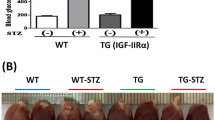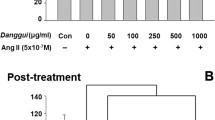Abstract
Objective: This study explores the synergistic effect of cardiomyoblast apoptosis induced by angiotensin II (Ang II) and Insulin-like growth factor (IGF)-I resistance, and elucidates the role of IGF-II via IGF-II receptor (R) and calcineurin pathways in apoptosis induced by Ang II and IGF-I resistance. Methods: Apoptosis of cultured cardiomyoblast H9c2 cells was assessed by DNA fragmentation on agarose gel electrophoresis, nuclear condensation stained with DAPI, and Western blot analysis of pro-apoptotic Bad and cytochrome c in various combinations of control, Ang II, antisense IGF (I or II), IGF (I or II) antibody, IGF (I or II) receptor (R) antibody, or calcineurin inhibitor (Cyclosporine A, (CsA)). Results: We found the following: (1) The combination of Ang II and IGF-I deficiencies had a synergistic effect on apoptosis, confirmed by DNA fragmentation, nuclei condensation, and increases in such pro-apoptotic proteins as Bad, cytochrome c, caspase 9, and caspase 3 in H9c2 cells. (2) IGF-II and IGF-IIR protein products were increased by antisense IGF-I and IGF-I resistance, but these IGF-II protein products were not affected by sense IGF-I and non-specific antibody IgG in H9c2 cells. (3) The alteration of Bad protein level and the release of cytochrome c, both induced by treatments containing combinations of Ang II and antisense IGF-I, IGF-I antibody or IGF-IR antibody, were inhibited by IGF-II antibody. (4) DNA fragmentation, Bad, and cytochrome c which was induced by treatments combining IGF-IR antibody with Ang II or combining IGF-IR antibody with IGF-II were remarkably attenuated by CsA. Conclusion: IGF-I deficiency and/or IGF-IR resistance induced apoptosis in cardiomyoblast cells. The apoptosis, which might have been caused by the upregulation of IGF-II and IGF-IIR genes possibly activated the downstream calcineurin pathway, was synergistically augmented by Ang II.
Similar content being viewed by others
References
Filippatos G, Tilak M, Pinillos H, Uhal BD (2001) Regulation of apoptosis by angiotensin II in the heart and lungs. Int J Mol Med 7:273–280
Adams V, Gielen S, Hambrecht R, Schuler G (2001) Apoptosis in skeletal muscle. Front Biosci 6:D1–D11
Harrison DG, Cai H, Landmesser U, Griendling KK (2003) Interactions of angiotensin II with NAD(P)H oxidase, oxidant stress and cardiovascular disease. J Renin Angiotensin Aldosterone Syst 4:51–61
Kang YJ (2001) Molecular and cellular mechanisms of cardiotoxicity. Environ Health Perspect 109(Suppl 1):27–34
Thrailkill KM (2000) Insulin-like growth factor-I in diabetes mellitus: its physiology, metabolic effects, and potential clinical utility. Diabetes Technol Ther 2:69–80
Tappy L, Fujita-Yamaguchi Y, LeBon TR, Boden G (1988) Antibodies to insulin-like growth factor I receptors in diabetes and other disorders. Diabetes 37:1708–1714
Ren J, Samson WK, Sowers JR (1999) Insulin-like growth factor I as a cardiac hormone: Physiological and pathophysiological implications in heart disease. J Mol Cell Cardiol 31:2049–2061
Fujio Y, Nguyen T, Wencker D, Kitsis RN, Walsh K (2000) Akt promotes survival of cardiomyocytes in vitro and protects against ischemia-reperfusion injury in mouse heart. Circulation 101:660–667
Parrizas M, Saltiel AR, LeRoith D (1997) Insulin-like growth factor I inhibits apoptosis using the phosphatidylinositol 3′-kinase and mitogen-activated protein kinase pathways. J Biol Chem 272:154–161
Chao W, Matsui T, Novikov MS, et al (2003) Strategic advantages of insulin-like growth factor-I expression for cardioprotection. J Gene Med 52:277–286
O’Connor R, Kauffmann-Zeh A, Liu Y, et al (1997) Identification of domains of the insulin-like growth factor I receptor that are required for protection from apoptosis. Mol Cell Biol 17:427–435
LeRoith D, Werner H, Beitner-Johnson D, Roberts CT Jr (1995) Molecular and cellular aspects of the insulin-like growth factor I receptor. Endocr Rev 16:143–163
Huang CY, Hao LY, Buetow DE (2002) Hypertrophy of cultured adult rat ventricular cardiomyocytes induced by antibodies against the insulin-like growth factor (IGF)-I or the IGF-I receptor is IGF-II-dependent. Mol Cell Biochem 233:65–72
Adachi S, Ito H, Akimoto H, et al (1994) Insulin-like growth factor-II induces hypertrophy with increased expression of muscle specific genes in cultured rat cardiomyocytes. J Mol Cell Cardiol 26:789–795
Ikezu T, Okamoto T, Giambarella U, Yokota T, Nishimoto I (1995) In vivo coupling of insulin-like growth factor II/mannose 6-phosphate receptor to heteromeric G proteins. Distinct roles of cytoplasmic domains and signal sequestration by the receptor. J Biol Chem 270:29224–29228
Molkentin JD, Lu JR, Antos CL, Markham B, Richardson J, Robbins J, Grant SR, Olson EN (1998) A calcineurin-dependent transcriptional pathway for cardiac hypertrophy. Cell 93:215–228
Wang HG, Pathan N, Ethell IM et al. (1999) Ca2±-induced apoptosis through calcineurin dephosphorylation of Bad. Science 284:339–343
Diep QN, El Mabrouk M, Yue P, Schiffrin EL (2002) Effect of AT(1) receptor blockade on cardiac apoptosis in angiotensin II-induced hypertension. Am J Physiol Heart Circ Physiol 282:H1635–H1641
Gonzalez A, Lopez B, Ravassa S, et al (2002) Stimulation of cardiac apoptosis in essential hypertension: Potential role of angiotensin II. Hypertension 39:75–80
Zarrilli R, Colantuoni V, Bruni CB (1992) Regulation of insulin-like-growth-factor-II gene expression in rat liver cells. (erratum in 15;210:1079) . Eur J Biochem 209:445–452
Vogt AM, Htun P, Kluge A, Zimmermann R, Schaper W (1997) Insulin-like growth factor-II delays myocardial infarction in experimental coronary artery occlusion. Cardiovasc Res 33:469–477
Sun FL, Dean WL, Kelsey G, Allen ND, Reik W (1997) Transactivation of IGF2 in a mouse model of Beckwith-Wiedemann syndrome. Nature 389:809–815
Nishimoto I, Murayama Y, Katada T, Ui M, Ogata E (1989) Possible direct linkage of insulin-like growth factor-II receptor with guanine nucleotide-binding proteins. J Biol Chem 264:14029–14038
Adams JW, Pagel AL, Means CK, Oksenberg D, Armstrong RC, Brown JH (2000) Cardiomyocyte apoptosis induced by Galphaq signaling is mediated by permeability transition pore formation and activation of the mitochondrial death pathway. Circ Res 87:1180–1187
Huang CY, Hao LY, Buetow DE (2002) Insulin-like growth factor-induced hypertrophy of cultured adult rat cardiomyocytes is L-type calcium-channel-dependent. Mol Cell Biochem 231:51–59
Huang CY, Hao LY, Buetow DE (2002) Insulin-like growth factor-II induces hypertrophy of adult cardiomyocytes via two alternative pathways. Cell Biol Int 26:737–739
Yamamura T, Otani H, Nakao Y, Hattori R, Osako M, Imamura H (2001) IGF-I differentially regulates Bcl-xL and Bax and confers myocardial protection in the rat heart. Am J Physiol Heart Circ Physiol 280:H1191–H1200
Hammerman MR (1987) Insulin-like growth factors and aging. Endocrinol Metab Clin North Am 16:995–1011
Candido R, Srivastava P, Cooper ME, Burrell LM (2003) Diabetes mellitus: A cardiovascular disease. Curr Opin Investig Drugs 4:1088–1094
Fiordaliso F, Li B, Latini R, et al (2000) Myocyte death in streptozotocin-induced diabetes in rats in angiotensin II- dependent. Lab Invest 80:513–527
Author information
Authors and Affiliations
Corresponding author
Additional information
The last two authors contributed equally.
Rights and permissions
About this article
Cite this article
Kuo, WW., Liu, CJ., Chen, LM. et al. Cardiomyoblast apoptosis induced by insulin-like growth factor (IGF)-I resistance is IGF-II dependent and synergistically enhanced by angiotensin II. Apoptosis 11, 1075–1089 (2006). https://doi.org/10.1007/s10495-006-7028-4
Published:
Issue Date:
DOI: https://doi.org/10.1007/s10495-006-7028-4




